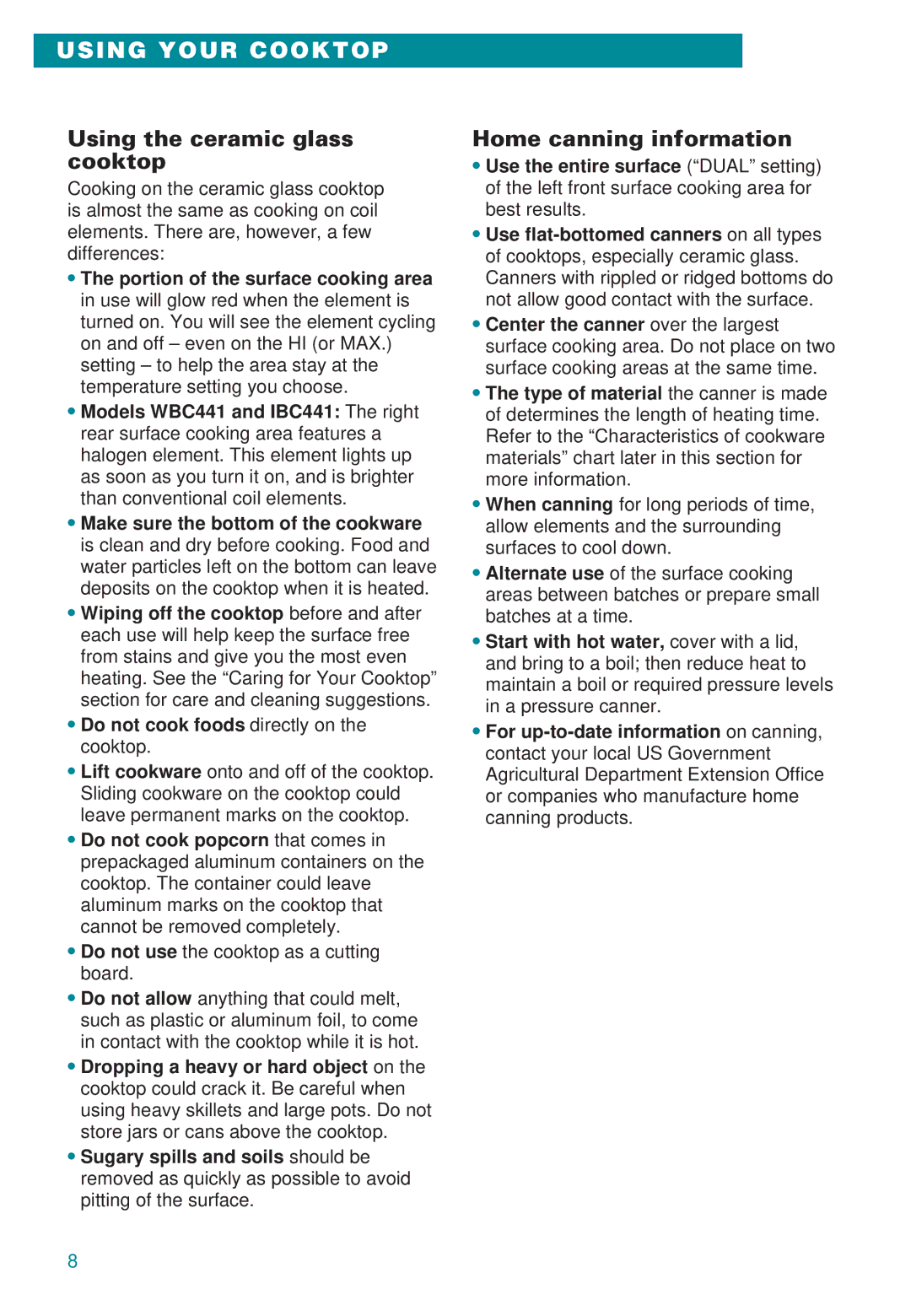USING YOUR COOKTOP
Using the ceramic glass | Home canning information | |
cooktop | • Use the entire surface (“DUAL” setting) | |
Cooking on the ceramic glass cooktop | of the left front surface cooking area for | |
is almost the same as cooking on coil | best results. | |
elements. There are, however, a few | • Use | |
differences: | of cooktops, especially ceramic glass. | |
• The portion of the surface cooking area | Canners with rippled or ridged bottoms do | |
in use will glow red when the element is | not allow good contact with the surface. | |
turned on. You will see the element cycling | • Center the canner over the largest | |
on and off – even on the HI (or MAX.) | surface cooking area. Do not place on two | |
setting – to help the area stay at the | surface cooking areas at the same time. | |
temperature setting you choose. | • The type of material the canner is made | |
• Models WBC441 and IBC441: The right | ||
of determines the length of heating time. | ||
rear surface cooking area features a | Refer to the “Characteristics of cookware | |
halogen element. This element lights up | materials” chart later in this section for | |
as soon as you turn it on, and is brighter | more information. | |
than conventional coil elements. | • When canning for long periods of time, | |
• Make sure the bottom of the cookware | ||
allow elements and the surrounding | ||
is clean and dry before cooking. Food and | surfaces to cool down. | |
water particles left on the bottom can leave | • Alternate use of the surface cooking | |
deposits on the cooktop when it is heated. | ||
areas between batches or prepare small | ||
• Wiping off the cooktop before and after | ||
batches at a time. | ||
each use will help keep the surface free | • Start with hot water, cover with a lid, | |
from stains and give you the most even | ||
and bring to a boil; then reduce heat to | ||
heating. See the “Caring for Your Cooktop” | ||
maintain a boil or required pressure levels | ||
section for care and cleaning suggestions. | ||
in a pressure canner. | ||
• Do not cook foods directly on the | ||
• For | ||
cooktop. | ||
contact your local US Government | ||
• Lift cookware onto and off of the cooktop. | ||
Agricultural Department Extension Office | ||
Sliding cookware on the cooktop could | or companies who manufacture home | |
leave permanent marks on the cooktop. | canning products. | |
• Do not cook popcorn that comes in |
| |
prepackaged aluminum containers on the |
| |
cooktop. The container could leave |
| |
aluminum marks on the cooktop that |
| |
cannot be removed completely. |
| |
• Do not use the cooktop as a cutting |
| |
board. |
| |
• Do not allow anything that could melt, |
| |
such as plastic or aluminum foil, to come |
| |
in contact with the cooktop while it is hot. |
| |
• Dropping a heavy or hard object on the |
| |
cooktop could crack it. Be careful when |
| |
using heavy skillets and large pots. Do not |
| |
store jars or cans above the cooktop. |
| |
• Sugary spills and soils should be |
| |
removed as quickly as possible to avoid |
| |
pitting of the surface. |
|
8
